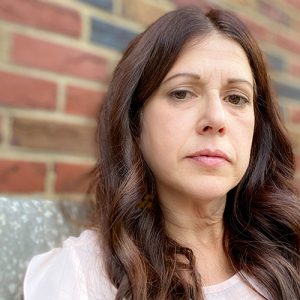Hi, I’m Maggie Cameron. I’m a mother, cousin, designer and Crohn’s and EHE survivor. I live just south of Pittsburgh, PA. I love to spend time with my family, work (yes, I love it), run and ski!
My EHE story started with my diagnosis of Crohn’s disease in 2009. The imaging showed a “thing” on my liver. It appeared to be a tangle of blood vessels and the doctors diagnosed it as a benign hemangioma, and all agreed to keep an eye on it.
To deal with my recurrent, post-surgical Crohn’s disease, the decision was made to add Humira, a powerful immunosuppressive biologic therapy to my treatment. After six months on Humira and repeat imaging, doctors were surprised to see that the hemangioma had grown significantly and was now quite large and had taken over most of the left lobe of my liver. Humira was immediately discontinued and a liver biopsy scheduled. The tumor was identified as EHE – it was something that my GI doctor had never heard of. Tissue was sent to the Cleveland Clinic for confirmation since it was such an unusual and rare diagnosis.
My diagnosis was confirmed in early September 2011, right before my 40th birthday. This was all very overwhelming and surreal. I Googled it, but all I could find was a Wikipedia entry and a few random mentions in some medical journals. The EHE Foundation hadn’t formed yet, and there was no Facebook support group. I was alone. At least that’s how it felt.
I was fortunate to be a candidate for surgical treatment. As I began to look for a liver surgeon, I found a photo of a transplant surgeon in Pittsburgh. He had a kind smile and a wore a bowtie. For whatever reason, I was drawn to him. I made an appointment with Dr. Wallis Marsh at UPMC. His demeanor was incredibly reassuring – he had resected someone with EHE 17 years prior! What are the chances of that? He joked, “My insurance agent has this. I resected her 17 years ago, and she’s still my insurance agent.” I felt incredibly lucky to have found a doctor who had seen this before and he was right in Pittsburgh. He was an angel for me at a time when I felt very lost. Since then, I’ve had two additional liver tumors ablated, and I’m now following with Dr. Melissa Burgess at Hillman Cancer Center in Pittsburgh.
For me, living with EHE is pretty manageable. The toughest part is convincing people outside of our community that it is serious and unpredictable. I walk this weird line of feeling guilty because I’m certainly not a sick as some people with EHE and feeling unsettled because that could change at any time. With no clear treatment path, “watch and wait” seems to be the best treatment for me right now.
The formation of the EHE Foundation gave me an incredible sense of gratitude. Here were women who were dedicating their precious time and energy to really advancing the medical discussions around rare sarcomas and especially EHE, to try to find a treatment or a cure. I am eternally grateful for their continued hard work. It’s absolutely humbling. This is a group of passionate people who have significantly changed the conversation and awareness around EHE and rare sarcomas. Because the EHE Foundation is so connected to its community, donating to it has a profound and measurable impact on the people and families touched by this disease.

